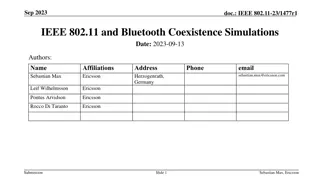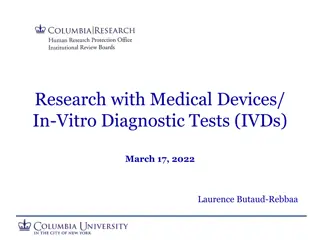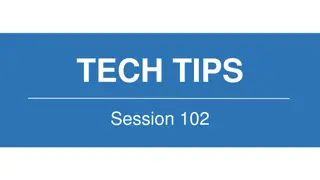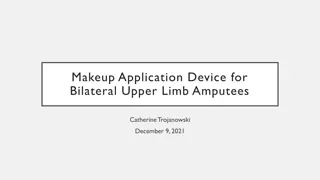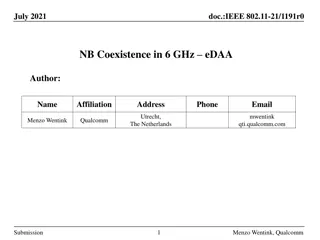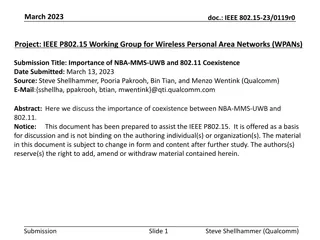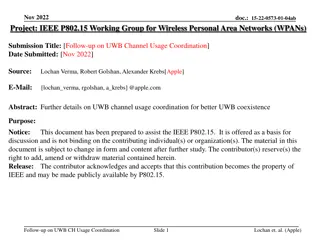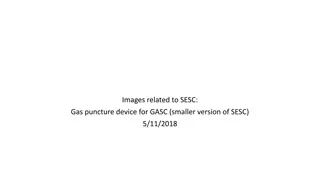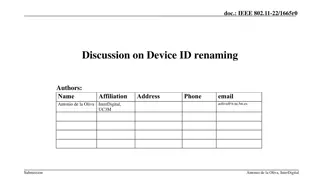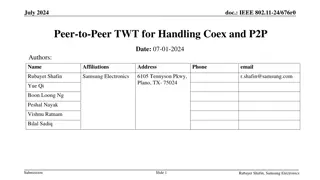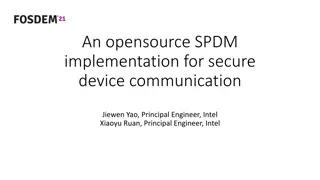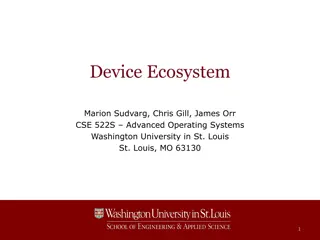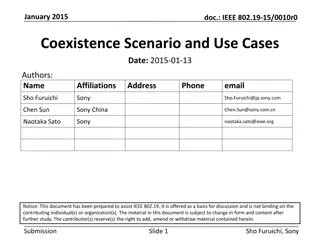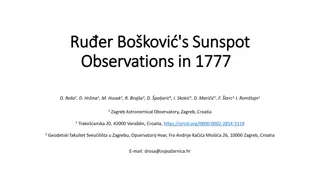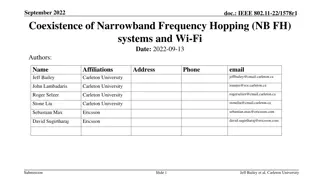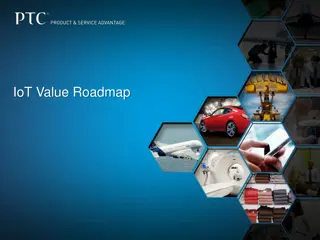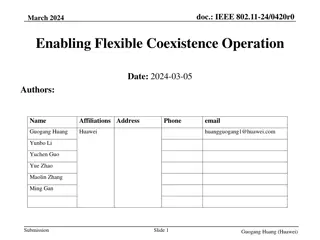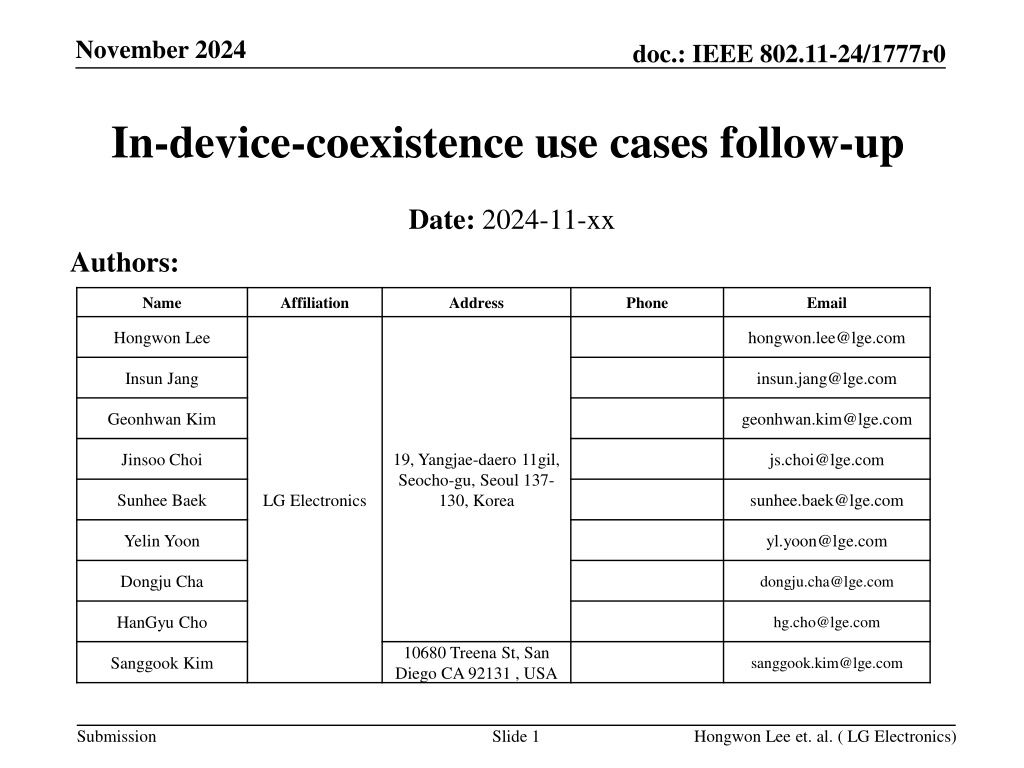
November 2024 IEEE 802.11-24 IDC Use Cases Overview
Explore the use cases for in-device coexistence mechanisms in the November 2024 IEEE 802.11-24 document. Detailed discussions on reporting unavailability for non-AP STAs and Mobile APs, covering both periodic and aperiodic events such as Bluetooth and UWB interactions. An insightful overview for understanding the IDC scenarios and implications.
Download Presentation

Please find below an Image/Link to download the presentation.
The content on the website is provided AS IS for your information and personal use only. It may not be sold, licensed, or shared on other websites without obtaining consent from the author. If you encounter any issues during the download, it is possible that the publisher has removed the file from their server.
You are allowed to download the files provided on this website for personal or commercial use, subject to the condition that they are used lawfully. All files are the property of their respective owners.
The content on the website is provided AS IS for your information and personal use only. It may not be sold, licensed, or shared on other websites without obtaining consent from the author.
E N D
Presentation Transcript
November 2024 doc.: IEEE 802.11-24/1777r0 In-device-coexistence use cases follow-up Date: 2024-11-xx Authors: Name Affiliation Address Phone Email Hongwon Lee hongwon.lee@lge.com Insun Jang insun.jang@lge.com Geonhwan Kim geonhwan.kim@lge.com 19, Yangjae-daero 11gil, Seocho-gu, Seoul 137- 130, Korea Jinsoo Choi js.choi@lge.com Sunhee Baek sunhee.baek@lge.com LG Electronics Yelin Yoon yl.yoon@lge.com Dongju Cha dongju.cha@lge.com HanGyu Cho hg.cho@lge.com 10680 Treena St, San Diego CA 92131 , USA Sanggook Kim sanggook.kim@lge.com Submission Slide 1 Hongwon Lee et. al. ( LG Electronics)
November 2024 doc.: IEEE 802.11-24/1777r0 Introduction The Motion related to defining a mechanism for a non-AP STA to report unavailability, which is related to both periodic and aperiodic in-device-coexistence(IDC), was passed in the July F2F meeting Several use cases for the IDC mechanism are discussed from the perspective of device roles, such as non-AP STA and Mobile AP[1]-[5] We should check if there are any other use cases we haven't discussed but should consider This contribution summarizes the use cases for the IDC mechanism that we have already discussed and focuses on identifying additional use cases we should consider Submission Slide 2 Hongwon Lee et. al. ( LG Electronics)
November 2024 doc.: IEEE 802.11-24/1777r0 IDC use cases for non-AP STAs There are clear use cases we should consider for a mechanism that can report the unavailability information of a non-AP STA Periodic events Bluetooth Low Energy(BLE) Advertising, for example, experiences unavailability for 100us every 500 milliseconds due to in-device coexistence (IDC) between Wi-Fi and BLE Bluetooth Audio Play(BR/EDR A2DP streaming), for example, experiences unavailability for 2ms every approximately 11.61ms due to IDC between Wi-Fi and Bluetooth UWB(Narrow-band assisted) ranging frame exchange between a non-AP STA and a non- WiFi device Etc. Aperiodic events Bluetooth(BT) Connection request from a peer non-Wi-Fi device; BT Connection response may occupy the medium for an unexpected duration in a device which has both Wi-Fi and BT UWB(Narrow-band assisted) ranging session initialization occurs through user interaction (e.g. for ranging measurement with an access control device) Etc. Submission Slide 3 Hongwon Lee et. al. ( LG Electronics)
November 2024 doc.: IEEE 802.11-24/1777r0 IDC use cases for Mobile APs There are clear use cases we should consider for mechanism which can report unavailability information of a Mobile AP Periodic events A Smart Phone user listens to music via Bluetooth while using Wi-Fi tethering A Smart Phone user transfer a picture via BT while using Wi-Fi tethering UWB(Narrow-band assisted) ranging frame exchange between non-AP STA and non- WiFi(e.g. UWB) device while using Wi-Fi tethering Etc. Aperiodic events Bluetooth(BT) Connection request from peer non-WiFi device while using Wi-Fi tethering; BT Connection response may occupy the medium for an unexpected duration in a device which has both Wi-Fi and BT UWB(Narrow-band assisted) ranging session initialization occurs through user interaction(e.g. for ranging measurement with an access control device) while using Wi-Fi tethering Etc. Submission Slide 4 Hongwon Lee et. al. ( LG Electronics)
November 2024 doc.: IEEE 802.11-24/1777r0 IDC use cases for infrastructure APs (?) Should we really not consider the IDC mechanism for infrastructure APs? If not, why? It is true that most infrastructure APs for non-enterprise environments currently only have Wi-Fi connectivity in the field However, if we look at infrastructure APs in an enterprise environment, many APs are not standalone but have multiple connectivity options Can it be guaranteed that most infrastructure APs will always have only Wi-Fi connectivity in the future? There may be an answer if we look at the smart home industry; other industries can also be considered Submission Slide 5 Hongwon Lee et. al. ( LG Electronics)
November 2024 doc.: IEEE 802.11-24/1777r0 Infrastructure AP in the future The requirements for multiple connectivity technologies in infrastructure APs are necessary due to the evolution of various industries; Wi-Fi may be no longer the only connectivity technology for infrastructure APs An infrastructure AP that has both Wi-Fi and non-WiFi connectivity (e.g., Thread Border Router, BLE, UWB, Zigbee, and more) can be deployed in specific environments such as smart home Multiple connectivity technologies are already applied to some Wi-Fi AP products such as Nest Wifi pro, Amazon eero Pro 6 and Edge-corE Wi-Fi Access Point, etc. We can also predict that many infrastructure APs with multiple connectivity will be feasible in the future by studying the architecture defined by the Matter standard (CSA) Matter considers Wi-Fi, Bluetooth/BLE, Thread(802.15.4) as connectivity technologies Some Matter devices can have the functionalities of Wi-Fi AP and Thread Border Router(to connect with Matter controlees) Submission Slide 6 Hongwon Lee et. al. ( LG Electronics)
November 2024 doc.: IEEE 802.11-24/1777r0 Wi-Fi Access Point types example Type A Type B Type C Current Time Increasing IDC issues Wi-Fi AP Wi-Fi AP Wi-Fi AP Thread Border Router BT/ BLE UWB Thread Border Router Device 1 Thread Border Router Device 1 Device 1 Device 3 Device 2 Device 4 Device 3 Device 2 Device 2 Device 3 Wi-Fi AP Products (e.g., IoT gateways) can currently cover Type A and/or Type B Type C may be feasible based on evolving standards and/or implementations aligned with future IoT requirements Type C has already become routine in the enterprise environment Submission Slide 7 Hongwon Lee et. al. ( LG Electronics)
November 2024 doc.: IEEE 802.11-24/1777r0 Conclusion We summarized the IDC use cases for non-AP STAs and Mobile APs that were discussed previously IDC use cases for infrastructure APs were examined through studying industries and products We believe that infrastructure APs with multiple connectivity technologies can feasibly cover various industries, such as smart homes, smart factories, smart buildings, and more We should also consider applying the IDC mechanism to infrastructure APs Submission Slide 8 Hongwon Lee et. al. ( LG Electronics)
November 2024 doc.: IEEE 802.11-24/1777r0 Straw Poll 1 Do you agree to include the following into the 11bn SFD? 11bn defines a mechanism for a UHR AP to report unavailability at TxOP level and defines or reuse/update existing mechanism a UHR AP to report long term (periodic) unavailability Applies when the peer STA(s) supports the mechanism Submission Slide 9 Hongwon Lee et. al. ( LG Electronics)
November 2024 doc.: IEEE 802.11-24/1777r0 References [1] 11-24/831r0, Periodic IDC use cases and considerations for signaling [2] 11-24/1108r1, Periodic IDC signaling for UHR Mobile AP [3] 11-24/1490r0, More Consideration of ICR/CRF for in-device-coexistence [4] 11-23/1103r0, In-Device Interference Discussion [5] 11-23/1934r0, In-Device Interference Mitigation Follow Up Submission Slide 10 Hongwon Lee et. al. ( LG Electronics)

